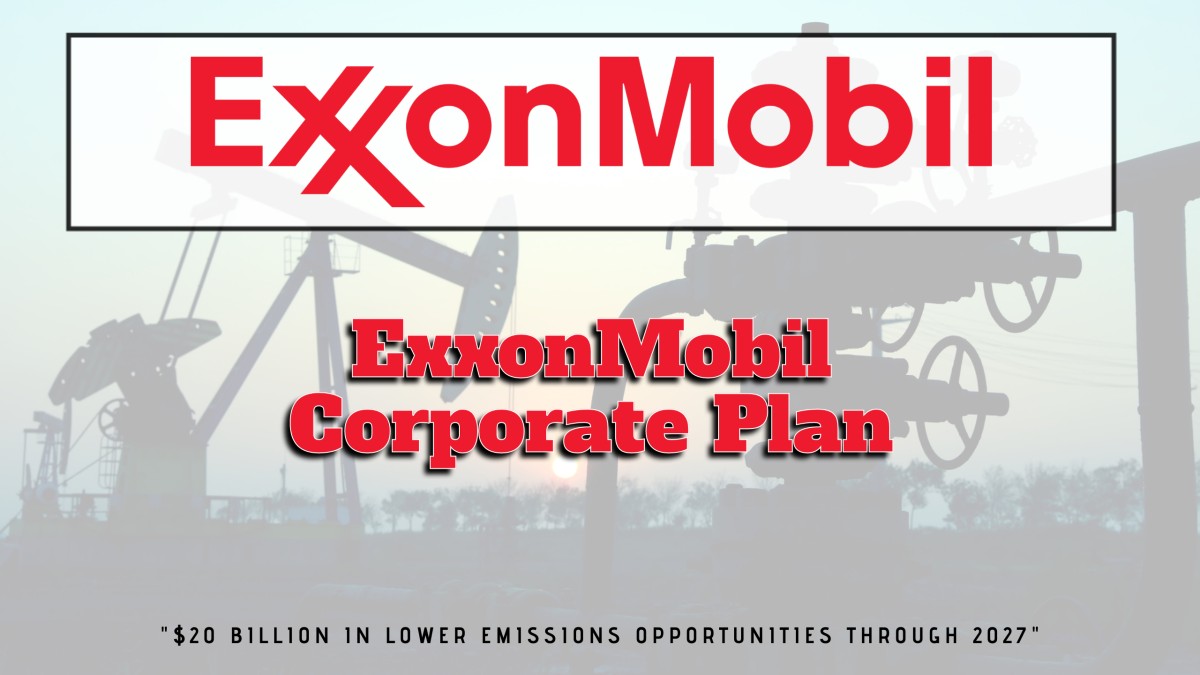
SPRING, TEXAS – ExxonMobil today gave an update to its Corporate Plan through 2027, reflecting continued execution of its strategy to provide the products society needs and to lower emissions, both its own and others’.
- Expecting capital investments to generate average returns of ~30%, with payback periods less than 10 years for greater than 90% of the capex2
- Pursuing more than $20 billion in lower emissions opportunities, up $3 billion
- Generated $9 billion in structural cost savings with $6 billion more expected by 2027
- Increasing pace of share repurchases to $20 billion per year from the Pioneer close through 2025, assuming reasonable market conditions
Since 2019, solid execution of ExxonMobil’s strategy has increased the earnings power of the corporation, adding about $10 billion to its annual earnings and cash flow at a real Brent price of $60 per barrel. These improvements provide a strong foundation to further grow annual earnings and cash flow by $14 billion from year-end 2023 through 2027, as the company continues to reduce structural costs and improve the mix of its business by growing production from low-cost-of-supply, advantaged assets and increasing sales of high-value performance chemicals, lower-emission fuels, and performance lubricants.
“By any measure, our plans have and will continue to deliver exceptional value,” said Darren Woods, chairman and chief executive officer. “We remain committed to providing the energy and products that raise living standards around the world while building a new business to reduce emissions in hard-to-decarbonize parts of the economy. ExxonMobil is uniquely equipped to do both, and we’re confident that both present significant opportunities for profitable growth.”
The company also announced it intends to deliver $6 billion in additional structural cost reductions by year-end 2027, bringing the total structural cost savings to approximately $15 billion versus 2019. Opportunities from consolidating value chains and centralizing key activities including maintenance, supply chain, procurement, order to cash, financial reporting, planning and analysis, and trading will enable further efficiency and execution effectiveness.
Upstream earnings potential is on track to more than double by 2027 versus 2019, resulting from investments in high-return, low-cost-of-supply projects. Over the next five years, approximately 90% of the company’s planned Upstream capital investments in new oil and flowing gas production are expected to generate returns greater than 10% at a Brent price of $35/bbl. The company has made good progress executing its plan to reduce Upstream operated greenhouse gas emissions intensity by 40% to 50% by 2030, compared with 2016 levels, having already achieved approximately half of this planned reduction.3
The company expects oil and gas production in 2024 to be about 3.8 million oil-equivalent barrels per day, rising to about 4.2 million oil-equivalent barrels per day by 2027, driven by growth in the Permian and Guyana.
Product Solutions is leveraging scale and technology advantages to nearly triple earnings potential by 2027 vs. 2019. Earnings growth is being delivered through structural cost reductions, strategic project execution that will double sales of high-value products, and other earnings improvements such as higher reliability, more efficient maintenance, facility optimization projects, and commercial improvements including trading. The portfolio value is being continuously upgraded through divestments of non-strategic assets and continued investment in advantaged sites to increase high-value products such as the recent chemical expansion in Baytown.
The Company’s capital allocation approach prioritizes competitively advantaged, high-return, low-cost-of-supply, value-accretive investments that enable ExxonMobil to lead the industry now and through the energy transition. The company now anticipates total annual capital expenditures and exploration expense of $23 billion to $25 billion in 2024 and $22 billion to $27 billion annually from 2025 through 2027, generating an average return of approximately 30%.2 Greater than 90% of the capex has payback periods less than 10 years.2 The increase in capex beginning in 2025 is driven by the growth in value-accretive Low Carbon Solutions opportunities to reduce emissions.
Increased cash flow and earnings enable further surplus cash generation and increased shareholder distributions. The company remains on track to complete $17.5 billion in share repurchases in 2023 as part of the $35 billion repurchase program previously announced for 2023 and 2024. After the Pioneer merger closes, the go-forward pace of the program in 2024 will be increased to $20 billion annually through 2025, assuming reasonable market conditions.
Low Carbon Solutions: Building a new value-accretive business
ExxonMobil is pursuing more than $20 billion of lower-emissions opportunities through 2027, which represents the third increase in the last three years, from an initial $3 billion in projects identified in early 2021. This is in addition to the company’s recent $5 billion all-stock acquisition of Denbury, which expanded carbon capture and storage opportunities through access to the largest CO2 pipeline network in the United States.
The company is pursuing a portfolio of opportunities in lithium, hydrogen, biofuels, and carbon capture and storage that in aggregate is expected to generate returns of approximately 15% and could reduce third-party emissions by more than 50 Mta by 20304,5. These lower emissions solutions help address climate change and closely align with ExxonMobil’s competitive advantages and core capabilities. Approximately 50% of the planned investments support building the company’s Low Carbon Solutions business, which reduces customers’ greenhouse gas emissions.
“We continue to see more opportunities to harness our technology, scale, and capabilities to implement real solutions to lower emissions and to profitably grow our Low Carbon Solutions business,” added Woods. “Success in accelerating emission reductions requires the development of nascent markets. We need technology-neutral durable policy support, transparent carbon pricing and accounting, and ultimately, customer commitments to support increased investment. We’re actively advocating for each of these areas so we can grow a profitable, and ultimately large, low carbon business.”
ExxonMobil is developing a leading position in lithium, fully leveraging its upstream skills, such as geoscience, reservoir management, and efficient drilling. It also taps the company’s downstream capabilities in fluid processing and extraction to separate the lithium from the brine. These skills and experiences underpin the company’s cost advantaged entry into the lithium business at scale, with strong returns and a lower environmental impact. Work has begun for the company’s first phase of lithium production in southwest Arkansas, an area known to have large, highly concentrated lithium deposits. First production is expected in 2027. The company is evaluating further growth opportunities in lithium globally. By 2030, ExxonMobil aims to produce enough lithium to supply the manufacturing needs of approximately 1 million EVs per year.6
The company recognizes the significant uncertainty in how the energy transition and its low carbon business will develop and expects to pace emissions-reduction investments, effectively allocating resources as markets, customer commitments, and policy evolve. This minimizes the downside risks while establishing an advantaged position to capture and maximize the upside potential.
The balance of the company’s low carbon capital will be used to reduce its own emissions in support of its 2030 emission reduction plans and its 2050 Scope 1 and 2 net-zero ambition. In the Permian Basin, the company is on track to reach net-zero emissions for unconventional operations by 2030, and previously announced it also expects to leverage its Permian greenhouse gas reductions plans to accelerate Pioneer’s net-zero ambition by 15 years, to 2035 from 2050.
Supporting materials for this press release are available on the ExxonMobil Investor Relations site.
2 Calculations are based on ExxonMobil plan. Calculations exclude capex for Corp & Fin, Operated by Others projects, exploration, LTO/maintenance/sustaining programs, and incubating projects and spend to reduce own emissions not supported by policy.
3 Emission reduction plans announced in December 2021 include a 20- to 30-percent reduction in corporate-wide greenhouse gas intensity by 2030 compared to 2016 levels. This will be supported by a 40- to 50-percent reduction in upstream greenhouse gas intensity, a 70- to 80-percent reduction in corporate-wide methane intensity, and a 60- to 70-percent reduction in corporate-wide flaring intensity compared to 2016. Plans cover Scope 1 and Scope 2 emissions for assets operated by the company.
4 Lower-emission investment portfolio delivers ~15% return on a capital-weighted basis under current and potential future government policies based on ExxonMobil projections. Calculations exclude capex for incubating projects and spend to reduce own emissions not supported by policy.
5 We see the opportunity to help other essential industries and customers achieve their goals to lower emissions. Estimates of GHG emissions are on a life cycle basis and include avoided and abated emissions from hydrogen, lower-emission fuels, and carbon capture and storage. For example, customers could avoid up to 25 MTA of their GHG emissions if all of ExxonMobil’s projected 2030 supply to the market of lower-emission fuels displaces conventional fuel refined from crude oil. Calculation is an ExxonMobil analysis illustrating the general benefits of lower-emission fuels based on estimated fuel CI from various third-party sources (such as Argonne National Labs’ GREET model) as compared against its conventional fuel alternate on a life cycle basis. Calculation is an estimate that represents a range of potential outcomes that are based on certain assumptions. Estimates are based on the potential implementation of projects or opportunities that are at various stages of maturity. Individual projects or opportunities may advance to a final investment decision by the company based on a number of factors, including availability of supportive policy and permitting, technology and infrastructure for cost-effective abatement, and alignment with our partners and other stakeholders. Actual avoided and abated emissions abatement may differ.
6 Based on ExxonMobil internal analysis.
###
About ExxonMobil
ExxonMobil, one of the largest publicly traded international energy and petrochemical companies, creates solutions that improve quality of life and meet society’s evolving needs.
The corporation’s primary businesses – Upstream, Product Solutions and Low Carbon Solutions – provide products that enable modern life, including energy, chemicals, lubricants, and lower emissions technologies. ExxonMobil holds an industry-leading portfolio of resources, and is one of the largest integrated fuels, lubricants, and chemical companies in the world. In 2021, ExxonMobil announced Scope 1 and 2 greenhouse gas emission-reduction plans for 2030 for operated assets, compared to 2016 levels. The plans are to achieve a 20-30% reduction in corporate-wide greenhouse gas intensity; a 40-50% reduction in greenhouse gas intensity of upstream operations; a 70-80% reduction in corporate-wide methane intensity; and a 60-70% reduction in corporate-wide flaring intensity.
With advancements in technology and the support of clear and consistent government policies, ExxonMobil aims to achieve net-zero Scope 1 and 2 greenhouse gas emissions from its operated assets by 2050. To learn more, visit exxonmobil.com and ExxonMobil’s Advancing Climate Solutions.
Follow us on LinkedIn, Instagram and X.
Important Information about the Transaction and Where to Find It
In connection with the proposed transaction between Exxon Mobil Corporation (“ExxonMobil”) and Pioneer Natural Resources Company (“Pioneer”), ExxonMobil and Pioneer will file relevant materials with the Securities and Exchange Commission (the “SEC”), including a registration statement on Form S-4 filed by ExxonMobil that will include a proxy statement of Pioneer that also constitutes a prospectus of ExxonMobil. A definitive proxy statement/prospectus will be mailed to stockholders of Pioneer. This communication is not a substitute for the registration statement, proxy statement or prospectus or any other document that ExxonMobil or Pioneer (as applicable) may file with the SEC in connection with the proposed transaction. BEFORE MAKING ANY VOTING OR INVESTMENT DECISION, INVESTORS AND SECURITY HOLDERS OF EXXONMOBIL AND PIONEER ARE URGED TO READ THE REGISTRATION STATEMENT, THE PROXY STATEMENT/PROSPECTUS AND ANY OTHER RELEVANT DOCUMENTS THAT ARE FILED OR WILL BE FILED WITH THE SEC, AS WELL AS ANY AMENDMENTS OR SUPPLEMENTS TO THESE DOCUMENTS, CAREFULLY AND IN THEIR ENTIRETY WHEN THEY BECOME AVAILABLE BECAUSE THEY CONTAIN OR WILL CONTAIN IMPORTANT INFORMATION ABOUT THE PROPOSED TRANSACTION AND RELATED MATTERS. Investors and security holders may obtain free copies of the registration statement and the proxy statement/prospectus (when they become available), as well as other filings containing important information about ExxonMobil or Pioneer, without charge at the SEC’s Internet website (http://www.sec.gov). Copies of the documents filed with the SEC by ExxonMobil will be available free of charge on ExxonMobil’s internet website at www.exxonmobil.com under the tab “investors” and then under the tab “SEC Filings” or by contacting ExxonMobil’s Investor Relations Department at investor.relations@exxonmobil.com. Copies of the documents filed with the SEC by Pioneer will be available free of charge on Pioneer’s internet website at https://investors.pxd.com/investors/financials/sec-filings/. The information included on, or accessible through, ExxonMobil’s or Pioneer’s website is not incorporated by reference into this communication.
Participants in the Solicitation
ExxonMobil, Pioneer, their respective directors and certain of their respective executive officers may be deemed to be participants in the solicitation of proxies in respect of the proposed transaction. Information about the directors and executive officers of Pioneer is set forth in its proxy statement for its 2023 annual meeting of stockholders, which was filed with the SEC on April 13, 2023, in its Form 10-K for the year ended December 31, 2022, which was filed with the SEC on February 23, 2023, in its Form 8-K filed on May 30, 2023, in its Form 8-K filed on April 26, 2023 and in its Form 8-K filed on February 13, 2023. Information about the directors and executive officers of ExxonMobil is set forth in its proxy statement for its 2023 annual meeting of stockholders, which was filed with the SEC on April 13, 2023, in its Form 10-K for the year ended December 31, 2022, which was filed with the SEC on February 22, 2023, in its Form 8-K filed on June 6, 2023 and in its Form 8-K filed on February 24, 2023. Additional information regarding the participants in the proxy solicitations and a description of their direct or indirect interests, by security holdings or otherwise, will be contained in the proxy statement/prospectus and other relevant materials filed with the SEC when they become available.
No Offer or Solicitation
This communication is for informational purposes and is not intended to, and shall not, constitute an offer to sell or the solicitation of an offer to buy any securities or a solicitation of any vote or approval, nor shall there be any offer, solicitation or sale of securities in any jurisdiction in which such offer, solicitation or sale would be unlawful prior to registration or qualification under the securities laws of any such jurisdiction. No offering of securities shall be made except by means of a prospectus meeting the requirements of Section 10 of the U.S. Securities Act of 1933, as amended.
Cautionary Statement
Statements of future events, conditions, expectations, plans or ambitions in this release or the subsequent discussion period are forward-looking statements. Similarly, discussions of future carbon capture, transportation, and storage, as well as biofuels, hydrogen, and other plans to reduce emissions of ExxonMobil, its affiliates, or companies it is seeking to acquire, are dependent on future market factors, such as continued technological progress, policy support and timely rule-making and permitting, and represent forward-looking statements. Actual future results, including financial and operating performance; potential earnings, cash flow, and rates of return; total capital expenditures and mix, including allocations of capital to low carbon investments; realization and maintenance of structural cost reductions and efficiency gains, including the ability to offset inflationary pressures; ambitions to reach Scope 1 and Scope 2 net zero from operated assets by 2050, to reach Scope 1 and 2 net zero in Upstream Permian Basin unconventional operated assets by 2030 and Pioneer Permian assets by 2035, to eliminate routine flaring in-line with World Bank Zero Routine Flaring, to reach near-zero methane emissions from operated assets and other methane initiatives, to meet ExxonMobil’s emission reduction plans and goals, divestment and start-up plans, and associated project plans as well as technology advances, including in the timing and outcome of projects to capture and store CO2, produce hydrogen, produce biofuels, product lithium, and use plastic waste as feedstock for advanced recycling; maintenance and turnaround activity; drilling and improvement programs; price and margin recovery; shareholder distributions; planned Pioneer or Denbury integration benefits; resource recoveries and production rates; and product sales levels and mix could differ materially due to a number of factors. These include global or regional changes in oil, gas, petrochemicals, or feedstock prices, differentials, or other market or economic conditions affecting the oil, gas, and petrochemical industries and the demand for our products; government policies supporting lower carbon investment opportunities such as the U.S. Inflation Reduction Act or policies limiting the attractiveness of investments such as European taxes on energy and unequal support for different methods of carbon capture; policy and consumer support for emission-reduction products and technology; variable impacts of trading activities; the outcome of competitive bidding and project wins; regulatory actions targeting public companies in the oil and gas industry; changes in local, national, or international laws, regulations, and policies affecting our business including with respect to the environment; taxes, trade sanctions, and actions taken in response to pandemic concerns; the ability to realize efficiencies within and across our business lines and to maintain current cost reductions as efficiencies without impairing our competitive positioning; the outcome and timing of exploration and development projects; decisions to invest in future reserves; reservoir performance, including variability in unconventional projects; the level and outcome of exploration projects and decisions to invest in future resources; timely completion of construction projects; war, civil unrest, attacks against the company or industry, and other political or security disturbances; expropriations, seizures, and capacity, insurance or shipping limitations by foreign governments or international embargoes; changes in consumer preferences; opportunities for and regulatory approval of investments or divestments that may arise such as the Pioneer acquisition; the outcome of our or competitors’ research efforts and the ability to bring new technology to commercial scale on a cost-competitive basis; the development and competitiveness of alternative energy and emission reduction technologies; unforeseen technical or operating difficulties including the need for unplanned maintenance; and other factors discussed here and in Item 1A. Risk Factors of our Annual Report on Form 10-K and under the heading “Factors Affecting Future Results” available through the Resources tab on the Investors page of our website at exxonmobil.com. All forward-looking statements are based on management’s knowledge and reasonable expectations at the time of this release and we assume no duty to update these statements as of any future date. Neither future distribution of this material nor the continued availability of this material in archive form on our website should be deemed to constitute an update or re-affirmation of these figures as of any future date. Any future update of these figures will be provided only through a public disclosure indicating that fact.
Forward-looking statements contained in this release regarding the potential for future earnings, cash flow, shareholder distributions, returns, structural cost reductions, capital and exploration expenditures, and volumes, including statements regarding future earnings potential and returns in the Upstream and Product Solutions segments and in our lower-carbon investments, are not forecasts of actual future results. These figures are provided to help quantify for illustrative purposes management’s view of the potential future results and goals of currently-contemplated management plans and objectives over the time periods shown, calculated on a basis consistent with our internal modeling assumptions. For all price point comparisons, unless otherwise indicated, we assume $60/bbl Brent crude prices and $3/mmbtu Henry Hub gas prices. Unless otherwise specified, crude prices are Brent prices. These are used for clear comparison purposes and are not necessarily representative of management’s internal price assumptions. All crude and natural gas prices for future years are adjusted for inflation from 2022. Energy, Chemical, and Specialty Product margins reflect annual historical averages for the 10-year period from 2010—2019 unless otherwise stated. Lower-emission returns are calculated based on current and potential future government policies based on ExxonMobil projections. These assumptions are not forecasts of actual future market conditions. Capital investment guidance in lower-emissions investments is based on plan, however actual investment levels will be subject to the availability of the opportunity set and focused on returns.
ExxonMobil reported emissions, including reductions and avoidance performance data, are based on a combination of measured and estimated data. Calculations are based on industry standards and best practices, including guidance from the American Petroleum Institute (API) and Ipieca. Emissions reported are estimates only, and performance data depends on variations in processes and operations, the availability of sufficient data, the quality of those data and methodology used for measurement and estimation. Emissions data is subject to change as methods, data quality, and technology improvements occur, and changes to performance data may be updated. Emissions reductions and avoidance estimates for non-ExxonMobil operated facilities are included in the equity data and similarly may be updated as changes in the performance data are reported. ExxonMobil’s plans to reduce emissions are good faith efforts based on current relevant data and methodology, which could be changed or refined. ExxonMobil works to continuously improve its approach to identifying, measuring, and addressing emissions. ExxonMobil actively engages with industry, including API and Ipieca, to improve emission factors and methodologies, including measurements and estimates.
The term “Upstream planned capital investments” as used in this release refers to projects that bring on new volumes with returns calculated on a money-forward basis. The term “flowing gas” as used in this release refers to gas available for sale that is not marketed as liquefied natural gas. The terms “performance chemicals” and “performance lubricants” as used in this release refers to products that provide differentiated performance for multiple applications through enhanced properties versus commodity alternatives and bring significant additional value to customers and end-users. The term “lower-emission fuels” as used in this release refers to fuels with lower life-cycle emissions than conventional transportation fuels for gasoline, diesel, and jet transport. The term “value-accretive” as used in this release includes investments in new and developing markets that are expected to generate returns based on support for these markets in the Inflation Reduction Act and similar policies, subject to permitting and regulatory approval of projects. The term “project” as used in this release can refer to a variety of different activities and does not necessarily have the same meaning as in any government payment transparency reports.
“Structural cost savings” and related terms describe decreases in cash operating expenses excluding energy and production taxes as a result of operational efficiencies, workforce reductions and other cost-saving measures that are expected to be sustainable compared to 2019 levels. Estimates of cumulative annual structural savings may be revised depending on whether cost reductions realized in prior periods are determined to be sustainable compared to 2019 levels.
This release summarizes highlights from ExxonMobil’s December 6, 2023 update for its corporate plans. For more information concerning the forward-looking statements, defined terms, and other information contained in this release, please refer to the complete presentation (including important information contained in the Cautionary Statement and Supplemental Information sections of the presentation) on the Investors section of our website at exxonmobil.com. Definitions and additional information concerning certain terms used in this release are also provided in the Frequently Used Terms available on the Investor page of our website at www.exxonmobil.com under the heading Resources.”









